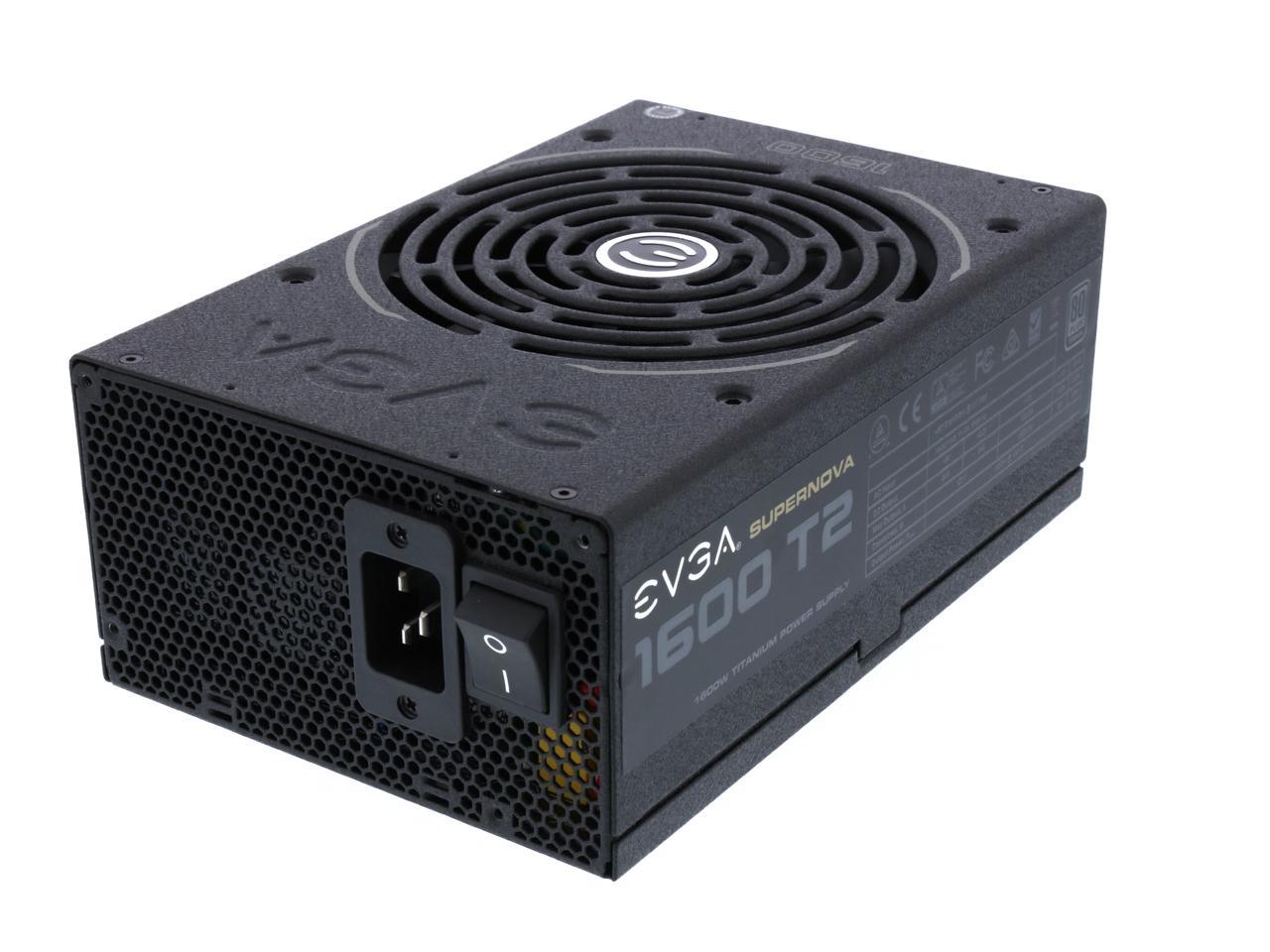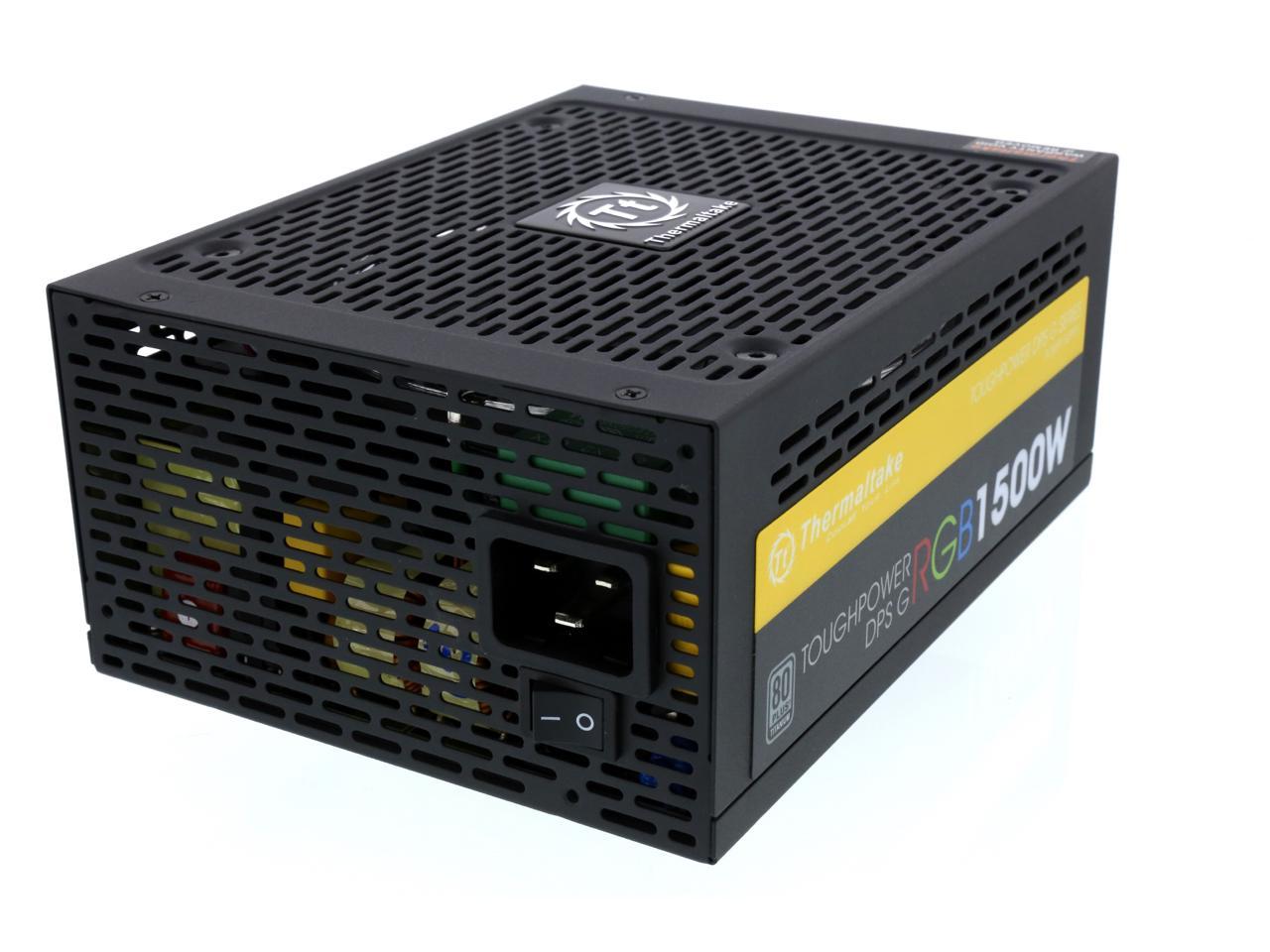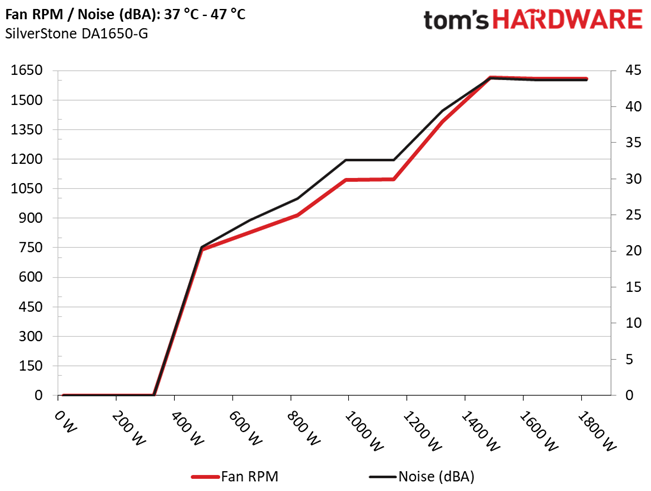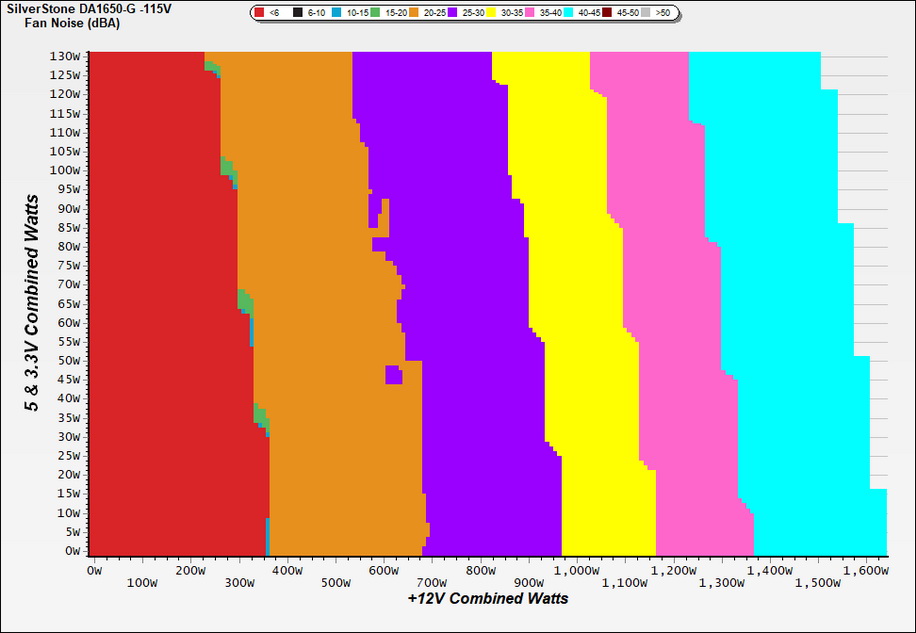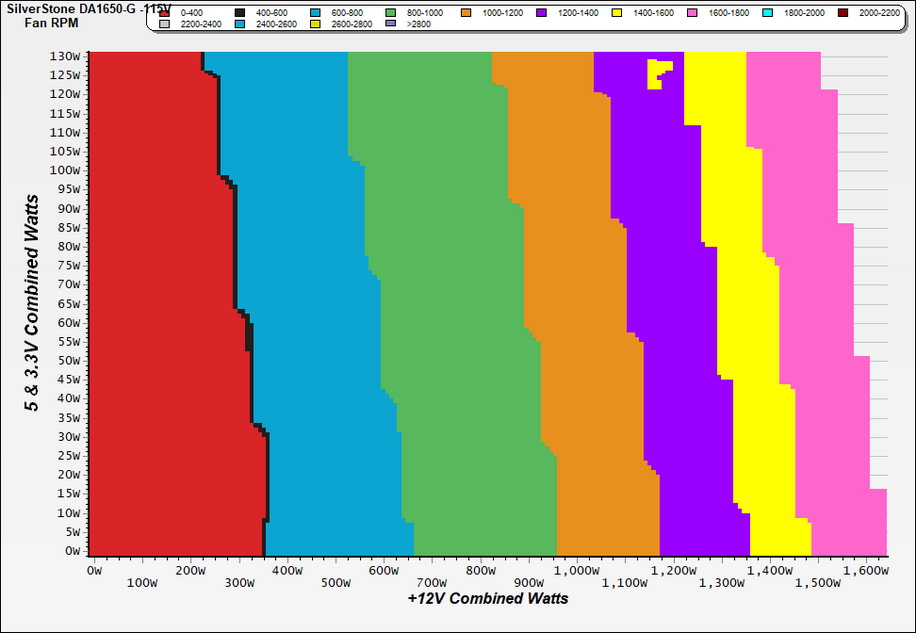Why you can trust Tom's Hardware
To learn more about our PSU tests and methodology, please check out How We Test Power Supply Units.
Primary Rails And 5VSB Load Regulation
The following charts show the main rails' voltage values recorded between a range of 40W up to the PSU's maximum specified load, along with the deviation (in percent). Tight regulation is an important consideration every time we review a power supply because it facilitates constant voltage levels despite varying loads. Tight load regulation also, among other factors, improves the system’s stability, especially under overclocked conditions and, at the same time, it applies less stress to the DC-DC converters that many system components utilize.
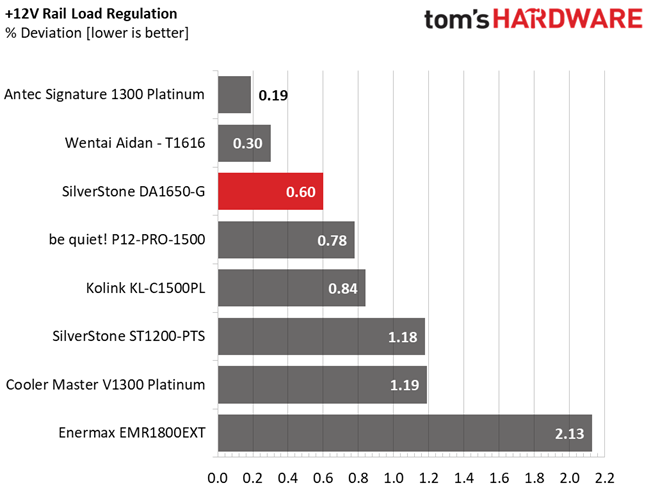
Results 1-8: Load Regulation
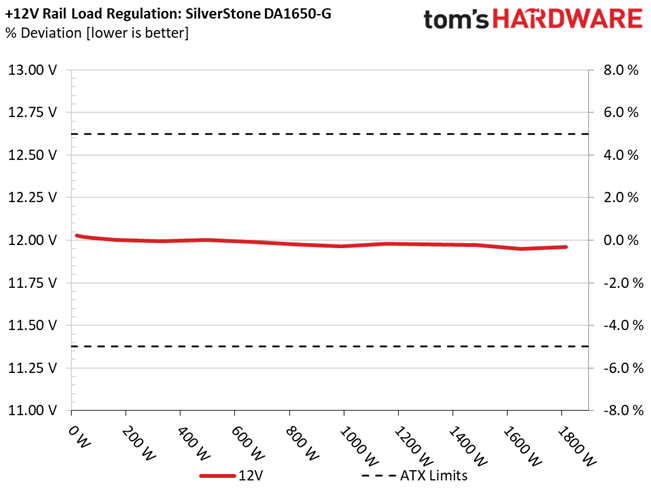
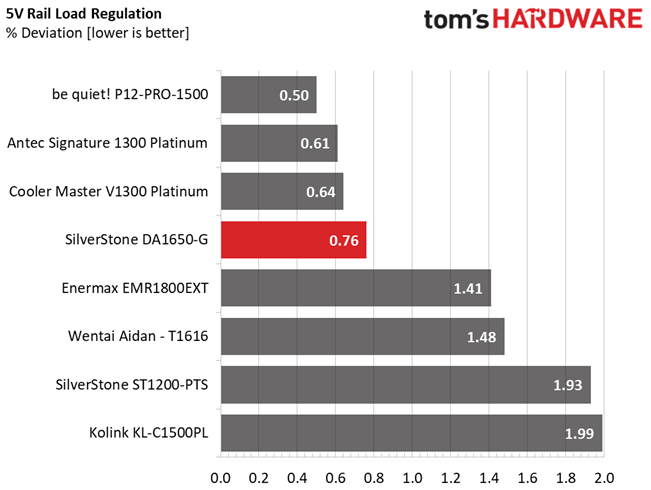

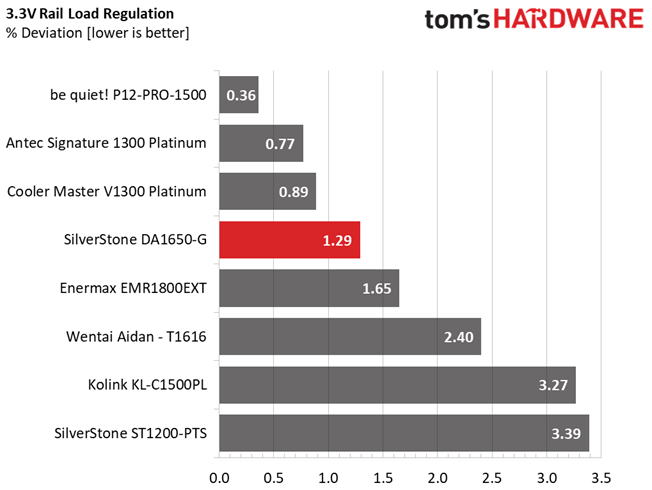
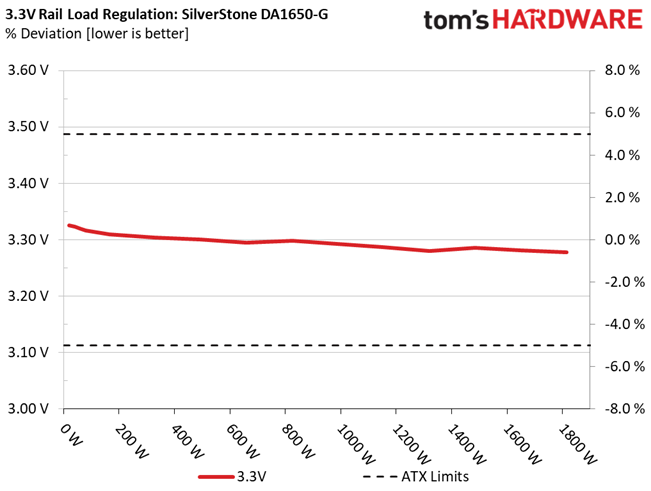
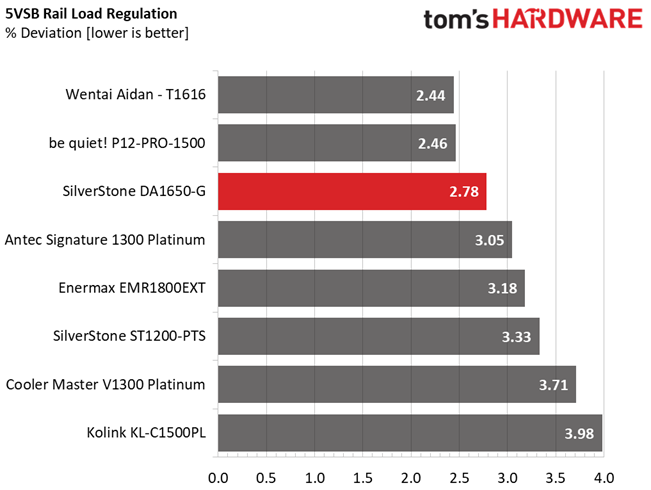
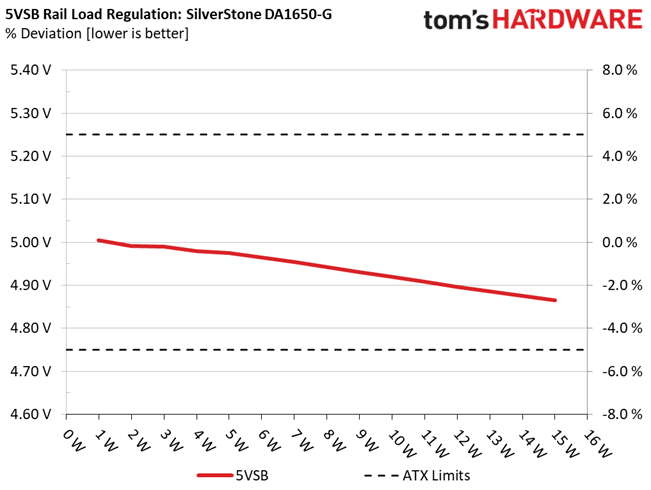
Load regulation is tight at 12V, where it matters the most.
Hold-Up Time
Put simply; hold-up time is the amount of time that the system can continue to run without shutting down or rebooting during a power interruption.
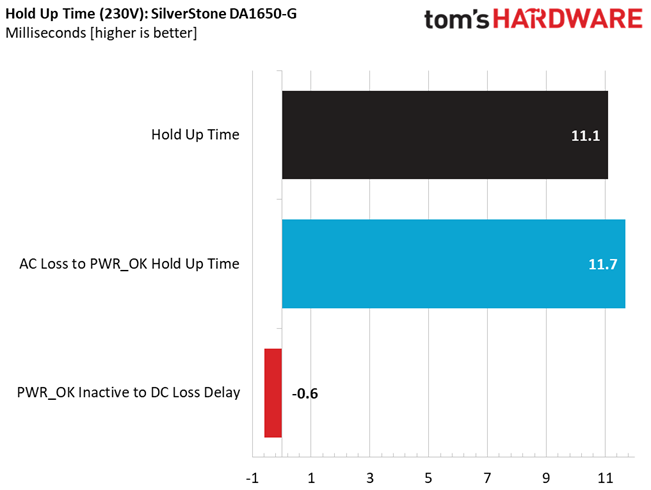
Results 9-12: Hold-Up Time
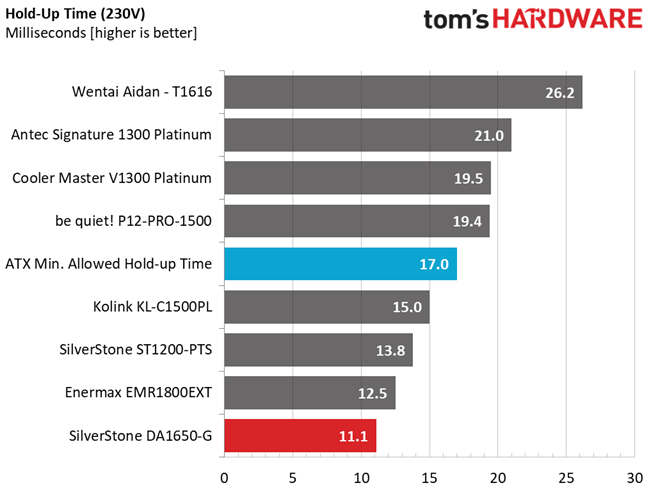
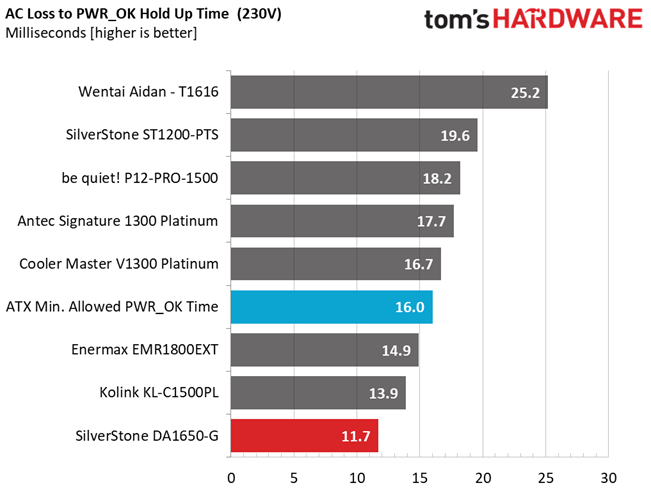
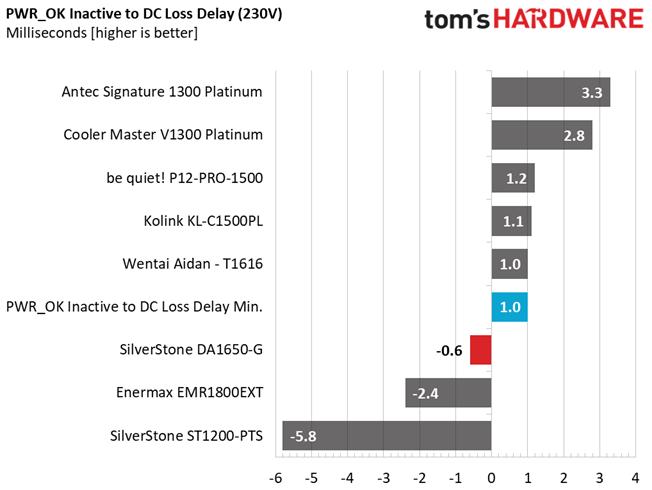
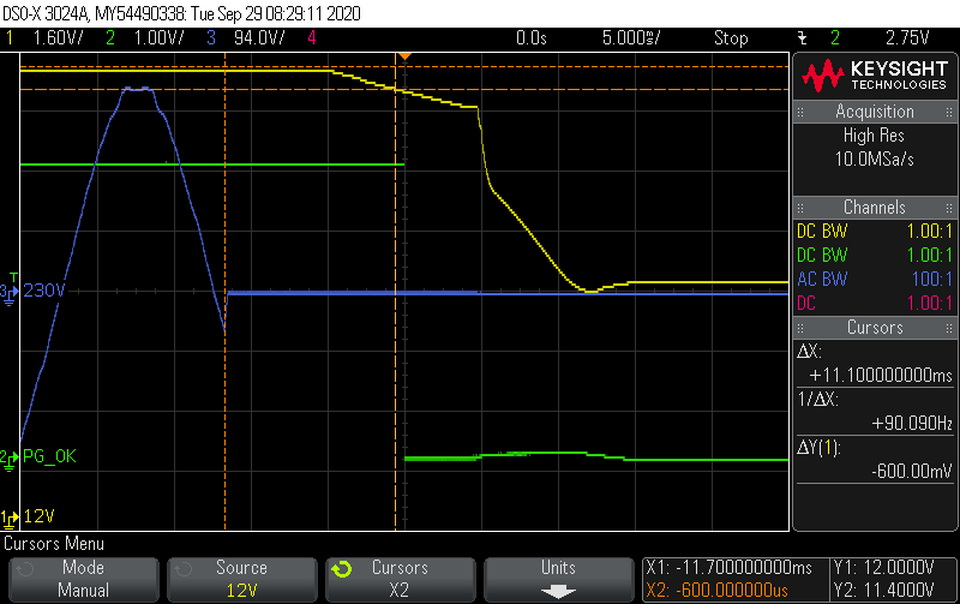
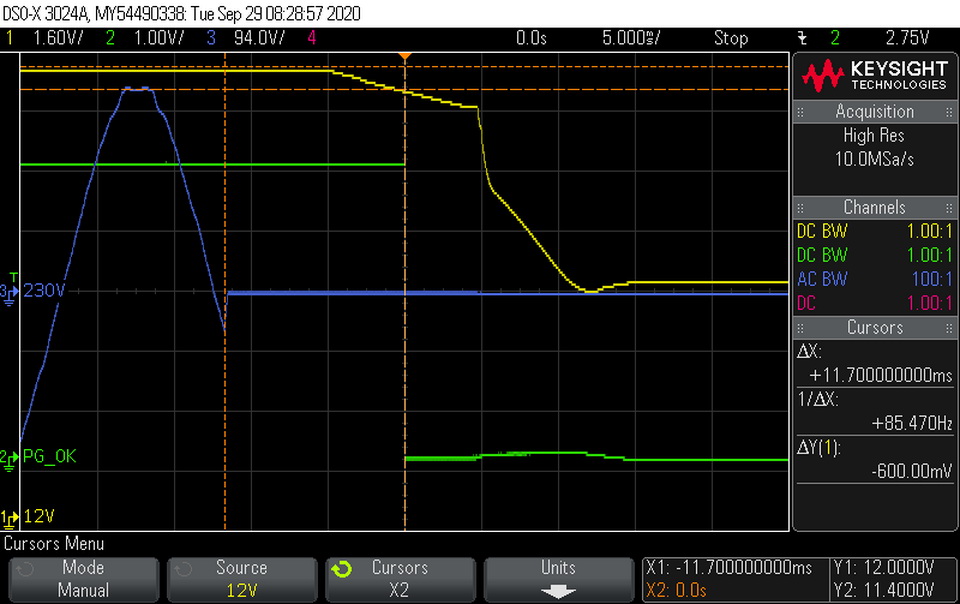
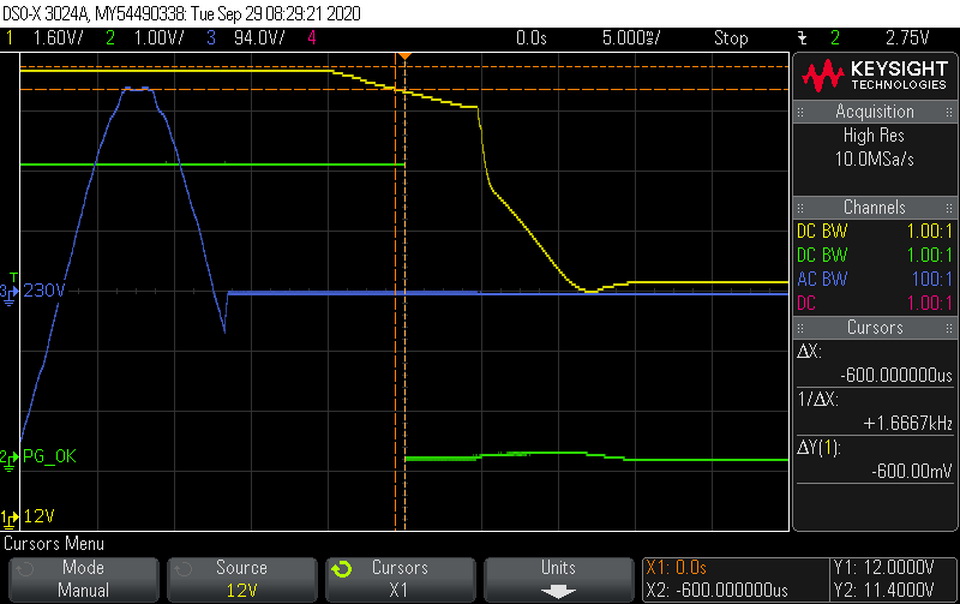
The hold-up time is lower than 17ms, but this is not the only problem here. The power ok signal is not accurate, and this can cause high stress to all system parts.
Inrush Current
Inrush current, or switch-on surge, refers to the maximum, instantaneous input current drawn by an electrical device when it is first turned on. A large enough inrush current can cause circuit breakers and fuses to trip. It can also damage switches, relays, and bridge rectifiers. As a result, the lower the inrush current of a PSU right as it is turned on, the better.
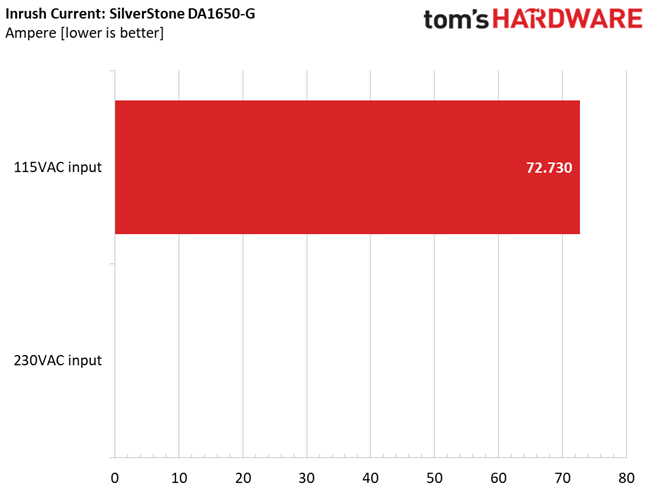
Results 13-14: Inrush Current
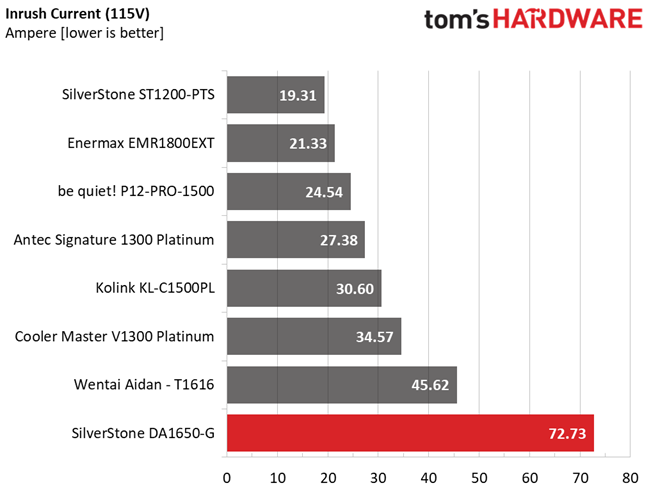
Inrush currents are high, especially with 230V where we weren't able to take a reading since the AC source kept on shutting down, because of the high, start-up, amperage.
Get Tom's Hardware's best news and in-depth reviews, straight to your inbox.
Leakage Current
In layman's terms, leakage current is the unwanted transfer of energy from one circuit to another. In power supplies, it is the current flowing from the primary side to the ground or the chassis, which in the majority of cases is connected to the ground. For measuring leakage current, we use a GW Instek GPT-9904 electrical safety tester instrument.
The leakage current test is conducted at 110% of the DUT's rated voltage input (so for a 230-240V device, we should conduct the test with 253-264V input). The maximum acceptable limit of a leakage current is 3.5 mA and it is defined by the IEC-60950-1 regulation, ensuring that the current is low and will not harm any person coming in contact with the power supply's chassis.
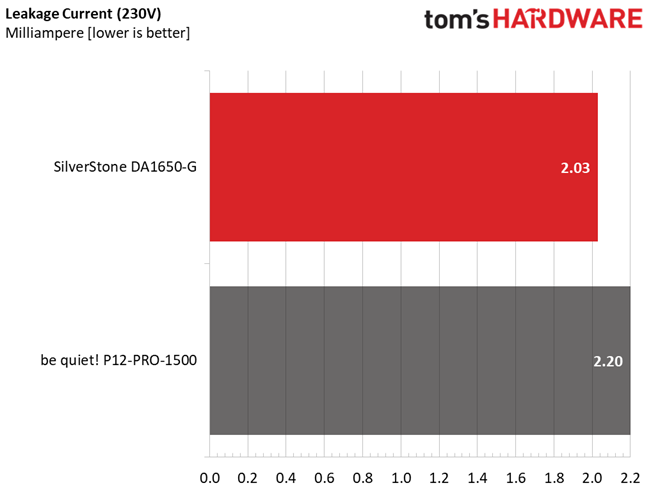
Leakage current is increased, but still lower than 3.5 mA.
10-110% Load Tests
These tests reveal the PSU's load regulation and efficiency levels under high ambient temperatures. They also show how the fan speed profile behaves under increased operating temperatures.
| Test # | 12V | 5V | 3.3V | 5VSB | DC/AC (Watts) | Efficiency | Fan Speed (RPM) | PSU Noise (dB[A]) | Temps (In/Out) | PF/AC Volts |
| 1 | 11.953A | 1.995A | 1.996A | 1.005A | 165.049 | 90.637% | 0 | <6.0 | 40.31°C | 0.989 |
| 12.001V | 5.011V | 3.309V | 4.975V | 182.098 | 44.27°C | 115.12V | ||||
| 2 | 24.940A | 2.997A | 2.997A | 1.209A | 330.064 | 92.359% | 0 | <6.0 | 40.99°C | 0.997 |
| 11.995V | 5.006V | 3.304V | 4.965V | 357.372 | 45.66°C | 115.11V | ||||
| 3 | 38.204A | 3.499A | 3.502A | 1.413A | 494.548 | 92.260% | 740 | 20.5 | 41.03°C | 0.998 |
| 12.001V | 5.003V | 3.300V | 4.954V | 536.039 | 46.47°C | 115.10V | ||||
| 4 | 51.583A | 4.004A | 4.006A | 1.619A | 659.754 | 91.957% | 829 | 24.3 | 41.66°C | 0.999 |
| 11.991V | 5.000V | 3.295V | 4.943V | 717.457 | 47.70°C | 115.09V | ||||
| 5 | 64.685A | 5.008A | 5.004A | 1.826A | 825.113 | 91.088% | 914 | 27.3 | 42.21°C | 0.999 |
| 11.975V | 4.993V | 3.298V | 4.930V | 905.840 | 49.13°C | 115.09V | ||||
| 6 | 77.710A | 6.016A | 6.017A | 2.000A | 989.457 | 90.300% | 1093 | 32.6 | 42.81°C | 0.999 |
| 11.965V | 4.988V | 3.292V | 4.921V | 1095.750 | 50.95°C | 115.08V | ||||
| 7 | 90.650A | 7.027A | 7.030A | 2.242A | 1154.934 | 89.448% | 1097 | 32.6 | 43.38°C | 0.999 |
| 11.978V | 4.983V | 3.287V | 4.908V | 1291.182 | 52.46°C | 115.07V | ||||
| 8 | 103.712A | 8.005A | 8.048A | 2.452A | 1320.195 | 88.352% | 1390 | 39.4 | 43.57°C | 0.999 |
| 11.975V | 4.977V | 3.280V | 4.896V | 1494.250 | 54.07°C | 115.06V | ||||
| 9 | 117.182A | 8.550A | 8.522A | 2.453A | 1485.310 | 87.259% | 1614 | 43.9 | 44.41°C | 0.999 |
| 11.971V | 4.973V | 3.286V | 4.893V | 1702.195 | 55.71°C | 115.06V | ||||
| 10 | 130.596A | 9.051A | 9.056A | 3.084A | 1650.098 | 86.028% | 1608 | 43.7 | 45.09°C | 0.999 |
| 11.948V | 4.974V | 3.281V | 4.865V | 1918.099 | 57.31°C | 115.05V | ||||
| 11 | 144.236A | 9.052A | 9.060A | 3.087A | 1814.927 | 84.588% | 1607 | 43.7 | 46.80°C | 0.999 |
| 11.961V | 4.973V | 3.278V | 4.861V | 2145.603 | 60.55°C | 115.03V | ||||
| CL1 | 0.099A | 16.003A | 16.000A | 0.000A | 133.667 | 82.422% | 0 | <6.0 | 42.80°C | 0.984 |
| 11.998V | 4.978V | 3.301V | 5.054V | 162.174 | 49.83°C | 115.14V | ||||
| CL2 | 137.509A | 1.000A | 1.001A | 1.000A | 1659.880 | 86.237% | 1605 | 43.7 | 45.91°C | 0.999 |
| 11.975V | 4.983V | 3.292V | 4.932V | 1924.795 | 57.98°C | 115.04V |
The PSU can handle extreme conditions but what bothers us is the CL1 test, where despite the high ambient temperature, the PSU's fan is not engaged because of the low load. The fan speed controller should consider both load and temperature, but it seems to be more load-oriented, and under some usage scenarios, this can be a problem. Lastly, the sky-high PF readings show that the APFC converter is ideally tuned.
20-80W Load Tests
In the following tests, we measure the PSU's efficiency at loads significantly lower than 10% of its maximum capacity (the lowest load the 80 PLUS standard measures). This is important for representing when a PC is idle with power-saving features turned on.
| Test # | 12V | 5V | 3.3V | 5VSB | DC/AC (Watts) | Efficiency | Fan Speed (RPM) | PSU Noise (dB[A]) | PF/AC Volts |
| 1 | 1.235A | 0.497A | 0.496A | 0.200A | 19.994 | 59.343% | 0 | <6.0 | 0.875 |
| 12.027V | 5.011V | 3.325V | 5.004V | 33.692 | 115.12V | ||||
| 2 | 2.470A | 0.998A | 0.992A | 0.401A | 39.983 | 73.433% | 0 | <6.0 | 0.934 |
| 12.020V | 5.005V | 3.323V | 4.992V | 54.448 | 115.12V | ||||
| 3 | 3.708A | 1.497A | 1.491A | 0.601A | 60.013 | 81.772% | 0 | <6.0 | 0.959 |
| 12.019V | 5.010V | 3.319V | 4.990V | 73.391 | 115.12V | ||||
| 4 | 4.941A | 1.997A | 1.991A | 0.803A | 79.964 | 84.700% | 0 | <6.0 | 0.968 |
| 12.015V | 5.006V | 3.316V | 4.980V | 94.408 | 115.12V |
It would be nice to see higher efficiency during the first test, but on the other hand, we shouldn't forget that 20W load is only 1.2% of this PSU's max-rated-capacity.
2% or 10W Load Test
Intel plans on raising the ante at efficiency levels under ultra-light loads. So from July 2020, the ATX spec will require 70% and higher efficiency with 115V input. The applied load is only 10W for PSUs with 500W and lower capacities, while for stronger units we dial 2% of their max-rated-capacity.
| Test # | 12V | 5V | 3.3V | 5VSB | DC/AC (Watts) | Efficiency | Fan Speed (RPM) | PSU Noise (dB[A]) | PF/AC Volts |
| 1 | 2.528A | 0.288A | 0.289A | 0.055A | 33.077 | 70.264% | 0 | <6.0 | 0.917 |
| 12.024V | 5.011V | 3.325V | 5.009V | 47.075 | 115.12V |
With 33W or 2% of its max-rated-capacity, the PSU manages to surpass 70% efficiency, as the newest ATX spec requires. This is impressive performance, which clarifies that high capacity PSUs can be highly efficient at super-light loads.
Efficiency & Power Factor
Next, we plotted a chart showing the PSU’s efficiency at low loads, and loads from 10 to 110% of its maximum rated capacity. The higher a PSU’s efficiency, the less energy goes wasted, leading to a reduced carbon footprint and lower electricity bills. The same goes for Power Factor.
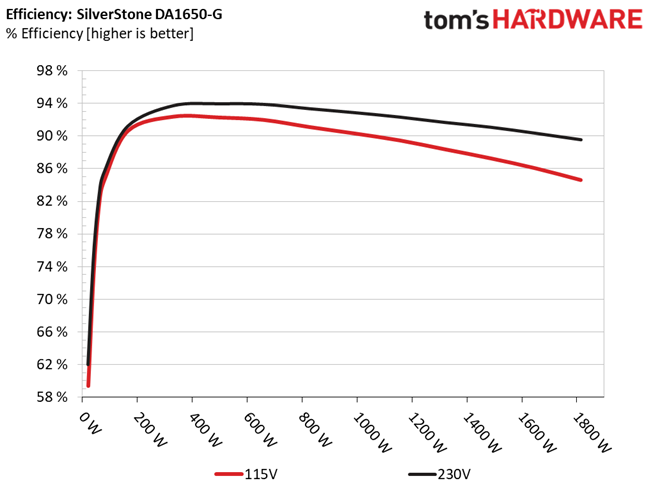
Results 15-18: Efficiency

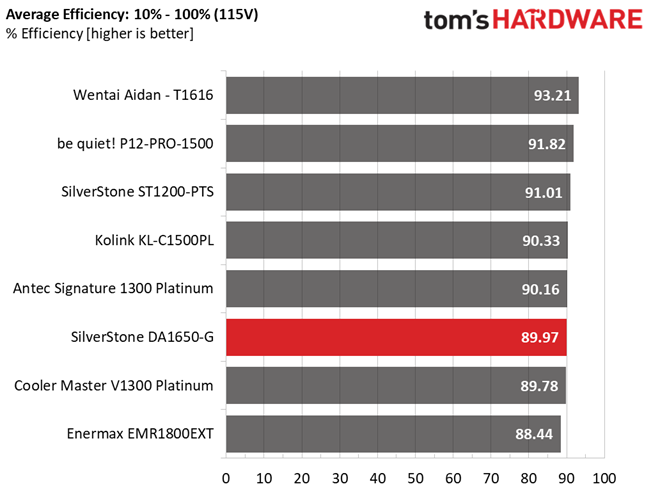
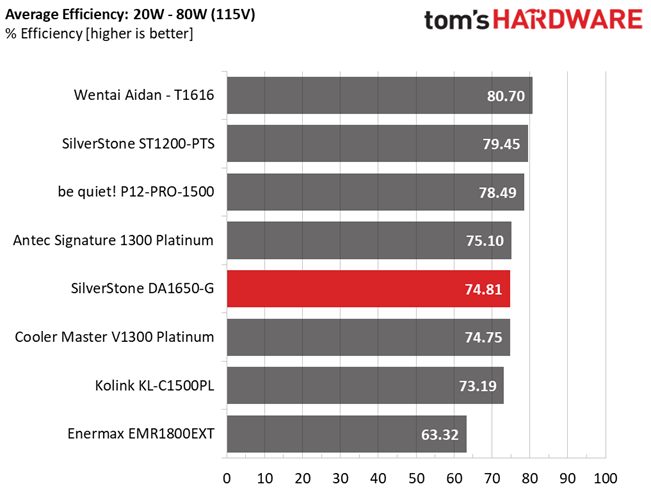

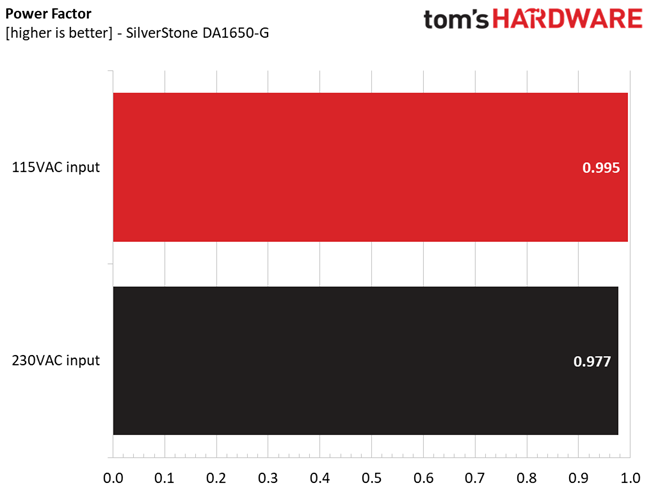
Considering its 80 PLUS Gold and Cybenetics ETA-A rating, the big SilverStone unit achieves high enough efficiency readings in all load regions.
5VSB Efficiency
| Test # | 5VSB | DC/AC (Watts) | Efficiency | PF/AC Volts |
| 1 | 0.100A | 0.512 | 71.012% | 0.097 |
| 5.117V | 0.721 | 115.13V | ||
| 2 | 0.250A | 1.278 | 76.208% | 0.195 |
| 5.112V | 1.677 | 115.13V | ||
| 3 | 0.550A | 2.806 | 77.600% | 0.305 |
| 5.101V | 3.616 | 115.13V | ||
| 4 | 1.000A | 5.085 | 78.159% | 0.377 |
| 5.084V | 6.506 | 115.13V | ||
| 5 | 1.500A | 7.598 | 78.193% | 0.418 |
| 5.065V | 9.717 | 115.13V | ||
| 6 | 3.000A | 15.010 | 77.487% | 0.470 |
| 5.003V | 19.371 | 115.13V |
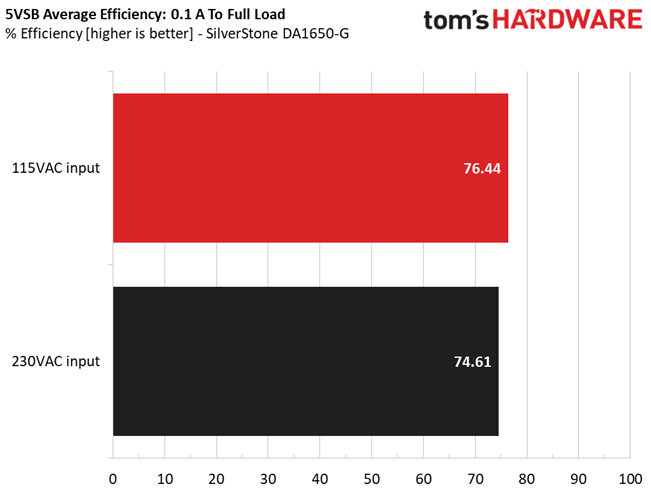
Results 19-20: 5VSB Efficiency

The 5VSB rail needs a small efficiency boost.
Power Consumption In Idle And Standby
| Mode | 12V | 5V | 3.3V | 5VSB | Watts | PF/AC Volts |
| Idle | 12.108V | 5.013V | 3.327V | 5.012V | 6.298 | 0.425 |
| 115.1V | ||||||
| Standby | 0.087 | 0.012 | ||||
| 115.1V |
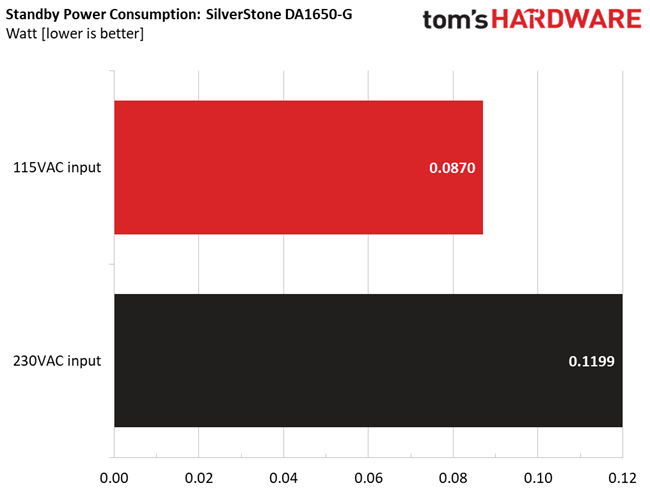
Results 21-22: Vampire Power

Vampire power could be lower, especially with 230V input.
Fan RPM, Delta Temperature, And Output Noise
All results are obtained between an ambient temperature of 37 to 47 degrees Celsius (98.6 to 116.6 degrees Fahrenheit).
The fan speed profile gets aggressive once the load exceeds 1300W to provide the airflow required to handle the increased thermal load.
The following results were obtained at 30 to 32 degrees Celsius (86 to 89.6 degrees Fahrenheit) ambient temperature.
Because of the high power output, the fan speed profile is not relaxed even under lower temperatures. With higher than 1380W loads, the PSU's fan outputs more than 40 dBA of noise.
MORE: Best Power Supplies
MORE: How We Test Power Supplies
MORE: All Power Supply Content
Current page: Load Regulation, Hold-Up Time, Inrush & Leakage Current, Efficiency and Noise
Prev Page Specifications and Part Analysis Next Page Protection Features, DC Power Sequencing, Cross-Load Tests and Infrared Images
Aris Mpitziopoulos is a contributing editor at Tom's Hardware, covering PSUs.
-
Awev Just wondering, what is the suggested retail price for this? And by offering only a three year warranty how much does that save a person compared to the competition, if you only plan to use it for say 2 1/2 years when the next generation of AMD (AM5 socket) and Intel CPUs are released, along with new GPUs - all requiring more power? How long would you have to own one or the other before it really pays for itself in warranty vs actual expected life?Reply
Please let me know if I missed the price in the article somewhere. -
Endymio And of course 90% of the buyers will be those with systems drawing half or less of that 1650 watts, but who have convinced themselves they "need" the extra headroom.Reply

